大厂算法面试之leetcode精讲18.队列
视频讲解(高效学习):点击学习
目录:
- 队列的特点:先进先出(FIFO)
- 队列的时间复杂度:入队和出队
O(1),查找O(n) - 优先队列:
priorityQueue,按优先级出队,实现Heap(Binary,Fibonacci...) - js里没有队列,但是可以用数组模拟
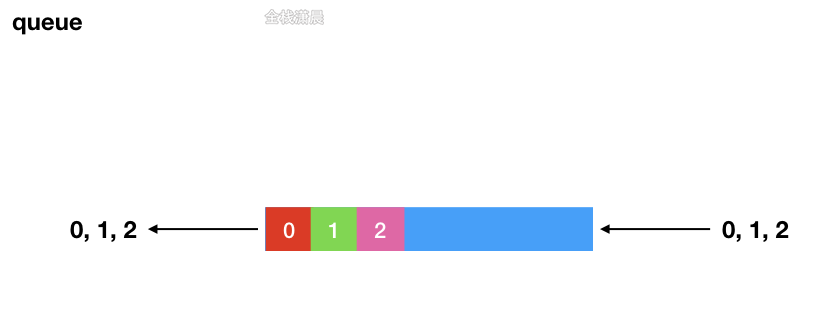
225. 用队列实现栈 (easy)
方法1.使用两个 Queue 实现
- 思路:还是考察栈和队列的熟悉程度,没有什么具体的工程实际意义,可以用两个队列来实现栈的功能,但是一个队列的数据导入另一个队列顺序还是没有改变,所以其中一个队列只是用来做备份的,在代码里queue2就是备份队列,入栈的时候,队列1入队,出栈的时候,如果队列1为空,则交换队列1和队列2,为的是将备份队列的元素全部加入队列1,然后将队列1中除了最后一个元素外全部出队,并且加入备份队列,
- 复杂度分析:push的时间复杂度为
O(1),pop的时间复杂度为O(n)。空间复杂度O(n),其中n是栈内元素的个数,用两个队列来存储
Js:
var MyStack = function() {
this.queue1 = [];
this.queue2 = [];//备份的队列
};
MyStack.prototype.push = function(x) {
this.queue1.push(x);
};
MyStack.prototype.pop = function() {
// 减少两个队列交换的次数, 只有当queue1为空时,交换两个队列
if(!this.queue1.length) {
[this.queue1, this.queue2] = [this.queue2, this.queue1];
}
while(this.queue1.length > 1) {//当队列1的元素数量大于1的时候不断将元素push进备份队列
this.queue2.push(this.queue1.shift());
}
return this.queue1.shift();//最后将队列1最后一个元素出队
};
MyStack.prototype.top = function() {
const x = this.pop();//查看栈顶,队列出队,然后在push进队列1
this.queue1.push(x);
return x;
};
MyStack.prototype.empty = function() {
return !this.queue1.length && !this.queue2.length;
};
Java:
class MyStack {
Queue<Integer> queue1;
Queue<Integer> queue2;
public MyStack() {
queue1 = new LinkedList<>();
queue2 = new LinkedList<>();
}
public void push(int x) {
queue2.offer(x);
while (!queue1.isEmpty()){
queue2.offer(queue1.poll());
}
Queue<Integer> queueTemp;
queueTemp = queue1;
queue1 = queue2;
queue2 = queueTemp;
}
public int pop() {
return queue1.poll();
}
public int top() {
return queue1.peek();
}
public boolean empty() {
return queue1.isEmpty();
}
}
方法2.使用一个 队列 实现
- 思路:使用一个 队列 实现,入栈的时候直接push进队列就行,出栈的时候将除了最后一个元素外的元素全部加入到队尾。
- 复杂度分析:push的时间复杂度为
O(1),pop的时间复杂度为O(n),空间复杂度O(n)
js:
var MyStack = function() {
this.queue = [];
};
MyStack.prototype.push = function(x) {
this.queue.push(x);
};
MyStack.prototype.pop = function() {
let size = this.queue.length;
while(size-- > 1) {//将除了最后一个元素外的元素全部加入到队尾。
this.queue.push(this.queue.shift());
}
return this.queue.shift();
};
MyStack.prototype.top = function() {
const x = this.pop();//先出栈,然后在加入队列
this.queue.push(x);
return x;
};
MyStack.prototype.empty = function() {
return !this.queue.length;
};
java:
class MyStack {
Deque<Integer> queue1;
public MyStack() {
queue1 = new ArrayDeque<>();
}
public void push(int x) {
queue1.addLast(x);
}
public int pop() {
int size = queue1.size();
size--;
while (size-- > 0) {
queue1.addLast(queue1.peekFirst());
queue1.pollFirst();
}
int res = queue1.pollFirst();
return res;
}
public int top() {
return queue1.peekLast();
}
public boolean empty() {
return queue1.isEmpty();
}
}
703. 数据流中的第 K 大元素 (easy)
方法1:暴力排序
- 思路:当数据流有新的元素的时候,重新按升序排序数组,倒数第k个元素就是第k大的数
- 复杂度分析:时间复杂度
O(c*zlogz),z为数据流的最长长度,c为加入元素的个数,排序复杂度是O(zlogz),加入c次排序就需要排序c次。
方法2:堆
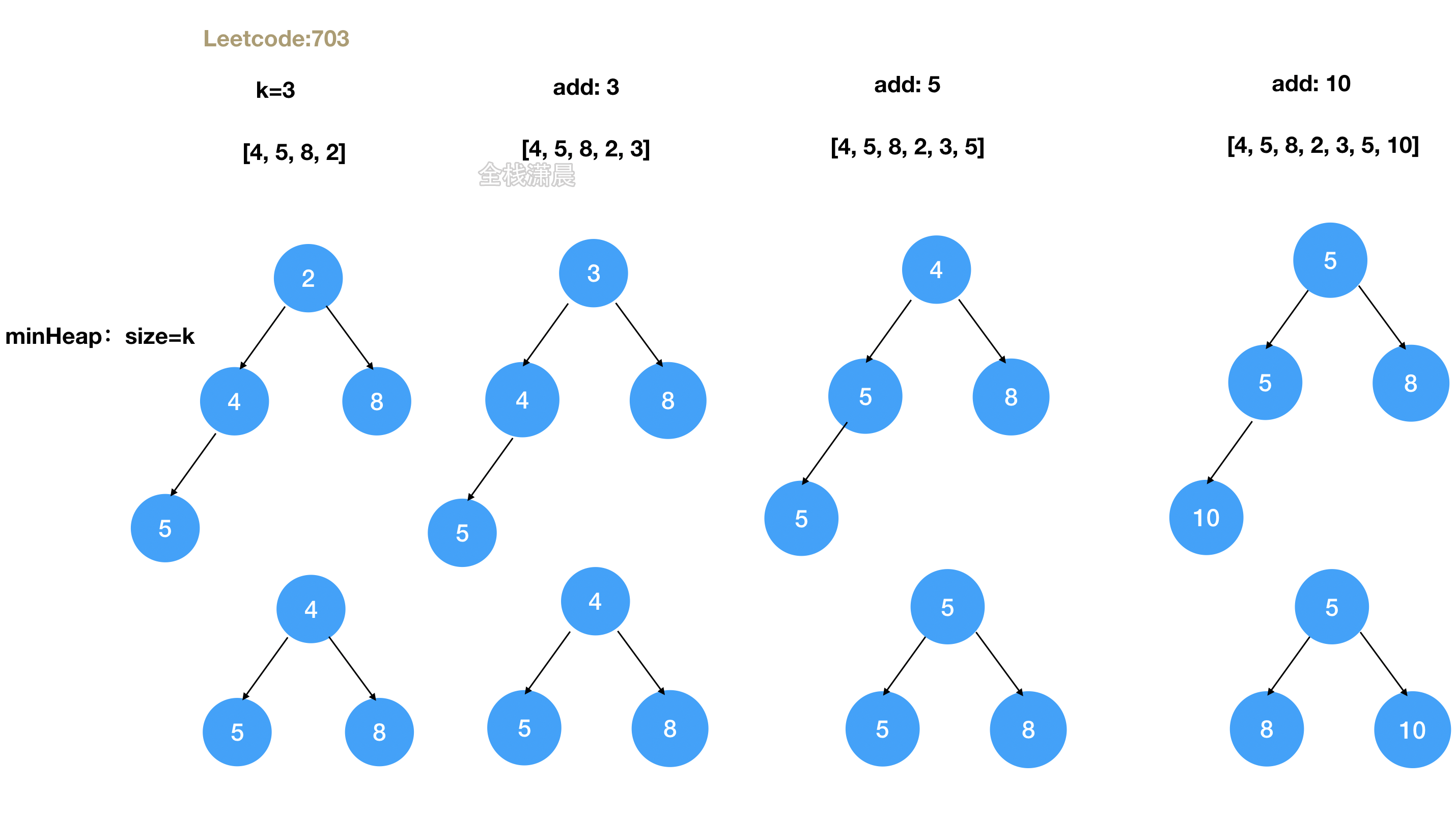
- 思路:用一个size是k的小顶堆来存贮前k个元素,堆顶是最小的元素,在循环数组的过程中,不断加入元素然后调整元素在堆中的位置,如果此时优先队列的大小大于 k,我们需要将优先队列的队头元素弹出,以保证优先队列的大小为 k,最后堆顶就是第K大元素的位置
- 复杂度分析:时间复杂度
O(nlogk),n是初始数组的大小,k是堆的大小,初始堆化和单次插入堆的复杂度都是O(logk),数组的每个数都要插入堆中一次,所以是O(nlogk)。 空间复杂度:O(k), 即堆的大小
js:
var KthLargest = function (k, nums) {
this.k = k;
this.heap = new Heap();
for (const x of nums) {//将数组中的数加入小顶堆
this.add(x);//加入小顶堆
}
};
KthLargest.prototype.add = function (val) {
this.heap.offer(val);//加入堆
if (this.heap.size() > this.k) {//大小超过了小顶堆的size,就从小顶堆删除一个最小的元素
this.heap.poll();//删除最小的元素
}
return this.heap.peek();//返回堆顶
};
class Heap {
constructor(comparator = (a, b) => a - b, data = []) {
this.data = data;
this.comparator = comparator;//比较器
this.heapify();//堆化
}
heapify() {
if (this.size() < 2) return;
for (let i = Math.floor(this.size()/2)-1; i >= 0; i--) {
this.bubbleDown(i);//bubbleDown操作
}
}
peek() {
if (this.size() === 0) return null;
return this.data[0];//查看堆顶
}
offer(value) {
this.data.push(value);//加入数组
this.bubbleUp(this.size() - 1);//调整加入的元素在小顶堆中的位置
}
poll() {
if (this.size() === 0) {
return null;
}
const result = this.data[0];
const last = this.data.pop();
if (this.size() !== 0) {
this.data[0] = last;//交换第一个元素和最后一个元素
this.bubbleDown(0);//bubbleDown操作
}
return result;
}
bubbleUp(index) {
while (index > 0) {
const parentIndex = (index - 1) >> 1;//父节点的位置
//如果当前元素比父节点的元素小,就交换当前节点和父节点的位置
if (this.comparator(this.data[index], this.data[parentIndex]) < 0) {
this.swap(index, parentIndex);//交换自己和父节点的位置
index = parentIndex;//不断向上取父节点进行比较
} else {
break;//如果当前元素比父节点的元素大,不需要处理
}
}
}
bubbleDown(index) {
const lastIndex = this.size() - 1;//最后一个节点的位置
while (true) {
const leftIndex = index * 2 + 1;//左节点的位置
const rightIndex = index * 2 + 2;//右节点的位置
let findIndex = index;//bubbleDown节点的位置
//找出左右节点中value小的节点
if (
leftIndex <= lastIndex &&
this.comparator(this.data[leftIndex], this.data[findIndex]) < 0
) {
findIndex = leftIndex;
}
if (
rightIndex <= lastIndex &&
this.comparator(this.data[rightIndex], this.data[findIndex]) < 0
) {
findIndex = rightIndex;
}
if (index !== findIndex) {
this.swap(index, findIndex);//交换当前元素和左右节点中value小的
index = findIndex;
} else {
break;
}
}
}
swap(index1, index2) {//交换堆中两个元素的位置
[this.data[index1], this.data[index2]] = [this.data[index2], this.data[index1]];
}
size() {
return this.data.length;
}
}
java:
class KthLargest {
PriorityQueue<Integer> pq;
int k;
public KthLargest(int k, int[] nums) {
this.k = k;
pq = new PriorityQueue<Integer>();
for (int x : nums) {
add(x);
}
}
public int add(int val) {
pq.offer(val);
if (pq.size() > k) {
pq.poll();
}
return pq.peek();
}
}
23. 合并K个升序链表 (hard)
方法1.分治

- 思路:自底而上归并,第一次归并2个链表,第二次归并4个链表...,每次归并不断合并两个有序链表,直到合并完所有分治后的链表
- 复杂度:时间复杂度
O(n * logk),n是每个链表节点数,k个链表个数,每次归并,链表数量较少一半,复杂度是O(logk),将两个链表合并成一个顺序链表复杂度是O(2n),所以时间复杂度是O(n * logk)。空间复杂度是O(logk),即递归的空格复杂度
js:
//自顶而下归并 先分在合
var mergeKLists = function (lists) {
// 当是空数组的情况下
if (!lists.length) {
return null;
}
// 合并两个排序链表
const merge = (head1, head2) => {
let dummy = new ListNode(0);
let cur = dummy;
// 新链表,新的值小就先接谁
while (head1 && head2) {
if (head1.val < head2.val) {
cur.next = head1;
head1 = head1.next;
} else {
cur.next = head2;
head2 = head2.next;
}
cur = cur.next;
}
// 如果后面还有剩余的就把剩余的接上
cur.next = head1 == null ? head2 : head1;
return dummy.next;
};
const mergeLists = (lists, start, end) => {
if (start + 1 == end) {
return lists[start];
}
// 输入的k个排序链表,可以分成两部分,前k/2个链表和后k/2个链表
// 如果将这前k/2个链表和后k/2个链表分别合并成两个排序的链表,再将两个排序的链表合并,那么所有链表都合并了
let mid = (start + end) >> 1;
let head1 = mergeLists(lists, start, mid);
let head2 = mergeLists(lists, mid, end);
return merge(head1, head2);
};
return mergeLists(lists, 0, lists.length);
};
//自底而上合并
var mergeKLists = function (lists) {
if (lists.length <= 1) return lists[0] || null;//当归并的节点只有一个时 返回这个节点
const newLists = [];
//自底而上归并,第一次归并大小为2的链表,第二次归并大小4的链表...
for (let i = 0; i < lists.length; i += 2) {
newLists.push(merge(lists[i], lists[i + 1] || null));
}
return mergeKLists(newLists);
};
const merge = (list_1, list_2) => {//合并两个有序链表
const dummyNode = new ListNode(0);
let p = dummyNode;
while (list_1 && list_2) {
if (list_1.val < list_2.val) {//先将小的节点加入
p.next = list_1;
list_1 = list_1.next;
} else {
p.next = list_2;
list_2 = list_2.next;
}
p = p.next;
}
p.next = list_1 ? list_1 : list_2;//遍历完成还有节点剩余
return dummyNode.next;
};
java:
class Solution {
public ListNode mergeKLists(ListNode[] lists) {
return mergeLists(lists, 0, lists.length - 1);
}
public ListNode mergeLists(ListNode[] lists, int start, int end) {
if (start == end) {
return lists[start];
}
if (start > end) {
return null;
}
int mid = (start + end) >> 1;
return merge(mergeLists(lists, start, mid), mergeLists(lists, mid + 1, end));
}
public ListNode merge(ListNode head1, ListNode head2) {
if (head1 == null || head2 == null) {
return head1 != null ? head1 : head2;
}
ListNode dummyNode = new ListNode(0);
ListNode cur = dummyNode;
while (head1 != null && head2 != null) {
if (head1.val < head2.val) {
cur.next = head1;
head1 = head1.next;
} else {
cur.next = head2;
head2 = head2.next;
}
cur = cur.next;
}
cur.next = (head1 != null ? head1 : head2);
return dummyNode.next;
}
}
方法2.优先队列
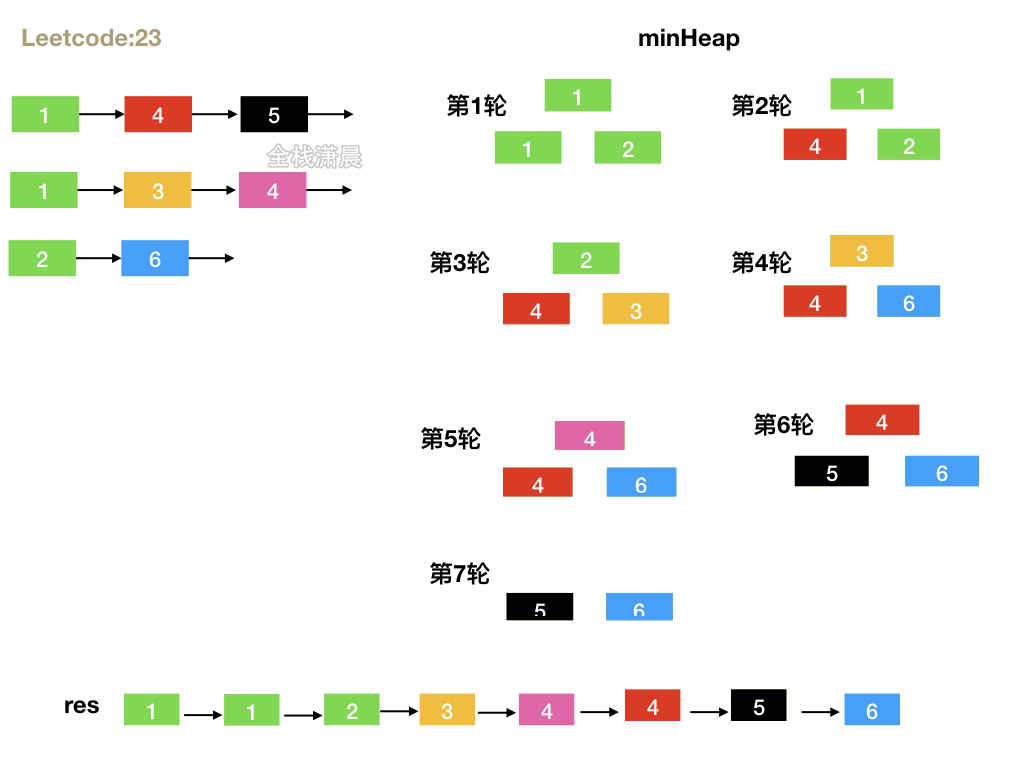
- 思路:新建小顶堆,小顶堆的大小是k,不断从每个链表的头节点开始不断加入小顶堆中,然后取出堆顶值,也就是最小值,然后继续往小顶堆中插入这个最小值在链表的next节点
- 复杂度:时间复杂度
O(kn * logk),优先队列的大小是k,每次插入和删除是O(logk),总共k * n的节点个数,每个节点插入删除一次,所以总的复杂度是O(kn*logk)。空间复杂度是O(k),即优先队列的大小
js:
class Heap { constructor(comparator = (a, b) => a - b, data = []) { this.data = data; this.comparator = comparator;//比较器 this.heapify();//堆化 } heapify() { if (this.size() < 2) return; for (let i = Math.floor(this.size()/2)-1; i >= 0; i--) { this.bubbleDown(i);//bubbleDown操作 } } peek() { if (this.size() === 0) return null; return this.data[0];//查看堆顶 } offer(value) { this.data.push(value);//加入数组 this.bubbleUp(this.size() - 1);//调整加入的元素在小顶堆中的位置 } poll() { if (this.size() === 0) { return null; } const result = this.data[0]; const last = this.data.pop(); if (this.size() !== 0) { this.data[0] = last;//交换第一个元素和最后一个元素 this.bubbleDown(0);//bubbleDown操作 } return result; } bubbleUp(index) { while (index > 0) { const parentIndex = (index - 1) >> 1;//父节点的位置 //如果当前元素比父节点的元素小,就交换当前节点和父节点的位置 if (this.comparator(this.data[index], this.data[parentIndex]) < 0) { this.swap(index, parentIndex);//交换自己和父节点的位置 index = parentIndex;//不断向上取父节点进行比较 } else { break;//如果当前元素比父节点的元素大,不需要处理 } } } bubbleDown(index) { const lastIndex = this.size() - 1;//最后一个节点的位置 while (true) { const leftIndex = index * 2 + 1;//左节点的位置 const rightIndex = index * 2 + 2;//右节点的位置 let findIndex = index;//bubbleDown节点的位置 //找出左右节点中value小的节点 if ( leftIndex <= lastIndex && this.comparator(this.data[leftIndex], this.data[findIndex]) < 0 ) { findIndex = leftIndex; } if ( rightIndex <= lastIndex && this.comparator(this.data[rightIndex], this.data[findIndex]) < 0 ) { findIndex = rightIndex; } if (index !== findIndex) { this.swap(index, findIndex);//交换当前元素和左右节点中value小的 index = findIndex; } else { break; } } } swap(index1, index2) {//交换堆中两个元素的位置 [this.data[index1], this.data[index2]] = [this.data[index2], this.data[index1]]; } size() { return this.data.length; }}var mergeKLists = function(lists) { const res = new ListNode(0); let p = res; const h = new Heap(comparator = (a, b) => a.val - b.val); lists.forEach(l => {//插入每个链表的第一个节点 if(l) h.offer(l); }) while(h.size()) {// const n = h.poll();//取出最小值 p.next = n;//最小值加入p的next后 p = p.next;//移动p节点 if(n.next) h.offer(n.next);//插入最小节点的后一个节点 } return res.next;};
java:
class Solution {
class Status implements Comparable<Status> {
int val;
ListNode ptr;
Status(int val, ListNode ptr) {
this.val = val;
this.ptr = ptr;
}
public int compareTo(Status status2) {
return this.val - status2.val;
}
}
PriorityQueue<Status> h = new PriorityQueue<Status>();
public ListNode mergeKLists(ListNode[] lists) {
for (ListNode node: lists) {
if (node != null) {
h.offer(new Status(node.val, node));
}
}
ListNode res = new ListNode(0);
ListNode p = res;
while (!h.isEmpty()) {
Status n = h.poll();
p.next = n.ptr;
p = p.next;
if (n.ptr.next != null) {
h.offer(new Status(n.ptr.next.val, n.ptr.next));
}
}
return res.next;
}
}
347. 前 K 个高频元素 (medium)
方法1:优先队列
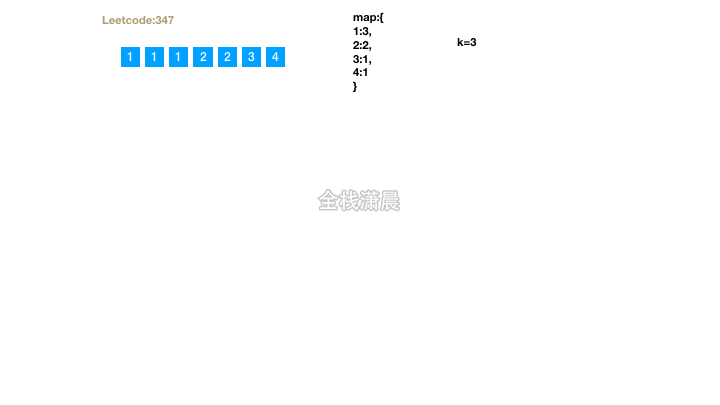
- 思路:循环数组,加入小顶堆,当堆的size超过k时,出堆,循环完成之后,堆中所有的元素就是前k大的数字
- 复杂度:时间复杂度
O(nlogk),循环n次,每次堆的操作是O(logk)。空间复杂度O(k),
js:
class Heap {
constructor(comparator = (a, b) => a - b, data = []) {
this.data = data;
this.comparator = comparator;//比较器
this.heapify();//堆化
}
heapify() {
if (this.size() < 2) return;
for (let i = Math.floor(this.size()/2)-1; i >= 0; i--) {
this.bubbleDown(i);//bubbleDown操作
}
}
peek() {
if (this.size() === 0) return null;
return this.data[0];//查看堆顶
}
offer(value) {
this.data.push(value);//加入数组
this.bubbleUp(this.size() - 1);//调整加入的元素在小顶堆中的位置
}
poll() {
if (this.size() === 0) {
return null;
}
const result = this.data[0];
const last = this.data.pop();
if (this.size() !== 0) {
this.data[0] = last;//交换第一个元素和最后一个元素
this.bubbleDown(0);//bubbleDown操作
}
return result;
}
bubbleUp(index) {
while (index > 0) {
const parentIndex = (index - 1) >> 1;//父节点的位置
//如果当前元素比父节点的元素小,就交换当前节点和父节点的位置
if (this.comparator(this.data[index], this.data[parentIndex]) < 0) {
this.swap(index, parentIndex);//交换自己和父节点的位置
index = parentIndex;//不断向上取父节点进行比较
} else {
break;//如果当前元素比父节点的元素大,不需要处理
}
}
}
bubbleDown(index) {
const lastIndex = this.size() - 1;//最后一个节点的位置
while (true) {
const leftIndex = index * 2 + 1;//左节点的位置
const rightIndex = index * 2 + 2;//右节点的位置
let findIndex = index;//bubbleDown节点的位置
//找出左右节点中value小的节点
if (
leftIndex <= lastIndex &&
this.comparator(this.data[leftIndex], this.data[findIndex]) < 0
) {
findIndex = leftIndex;
}
if (
rightIndex <= lastIndex &&
this.comparator(this.data[rightIndex], this.data[findIndex]) < 0
) {
findIndex = rightIndex;
}
if (index !== findIndex) {
this.swap(index, findIndex);//交换当前元素和左右节点中value小的
index = findIndex;
} else {
break;
}
}
}
swap(index1, index2) {//交换堆中两个元素的位置
[this.data[index1], this.data[index2]] = [this.data[index2], this.data[index1]];
}
size() {
return this.data.length;
}
}
var topKFrequent = function (nums, k) {
const map = new Map();
for (const num of nums) {//统计频次
map.set(num, (map.get(num) || 0) + 1);
}
//创建小顶堆
const priorityQueue = new Heap((a, b) => a[1] - b[1]);
//entry 是一个长度为2的数组,0位置存储key,1位置存储value
for (const entry of map.entries()) {
priorityQueue.offer(entry);//加入堆
if (priorityQueue.size() > k) {//堆的size超过k时,出堆
priorityQueue.poll();
}
}
const ret = [];
for (let i = priorityQueue.size() - 1; i >= 0; i--) {//取出前k大的数
ret[i] = priorityQueue.poll()[0];
}
return ret;
};
java:
class Solution {
public int[] topKFrequent(int[] nums, int k) {
int[] ret = new int[k];
HashMap<Integer, Integer> map = new HashMap<>();
for (int num : nums) {
map.put(num, map.getOrDefault(num, 0) + 1);
}
Set<Map.Entry<Integer, Integer>> entries = map.entrySet();
PriorityQueue<Map.Entry<Integer, Integer>> priorityQueue = new PriorityQueue<>((o1, o2) -> o1.getValue() - o2.getValue());
for (Map.Entry<Integer, Integer> entry : entries) {
priorityQueue.offer(entry);
if (priorityQueue.size() > k) {
priorityQueue.poll();
}
}
for (int i = k - 1; i >= 0; i--) {
ret[i] = priorityQueue.poll().getKey();
}
return ret;
}
}
692. 前K个高频单词(medium)
方法1:排序
js:
var topKFrequent = function (words, k) {
const map = {};
words.forEach(v => map[v] = (map[v] || 0) + 1);
const keys = Object.keys(map).sort((a, b) => map[b] - map[a] || a.localeCompare(b))
return keys.slice(0, k);
};
方法2:堆
js:
class Heap {
constructor(comparator = (a, b) => a - b, data = []) {
this.data = data;
this.comparator = comparator;//比较器
this.heapify();//堆化
}
heapify() {
if (this.size() < 2) return;
for (let i = Math.floor(this.size()/2)-1; i >= 0; i--) {
this.bubbleDown(i);//bubbleDown操作
}
}
peek() {
if (this.size() === 0) return null;
return this.data[0];//查看堆顶
}
offer(value) {
this.data.push(value);//加入数组
this.bubbleUp(this.size() - 1);//调整加入的元素在小顶堆中的位置
}
poll() {
if (this.size() === 0) {
return null;
}
const result = this.data[0];
const last = this.data.pop();
if (this.size() !== 0) {
this.data[0] = last;//交换第一个元素和最后一个元素
this.bubbleDown(0);//bubbleDown操作
}
return result;
}
bubbleUp(index) {
while (index > 0) {
const parentIndex = (index - 1) >> 1;//父节点的位置
//如果当前元素比父节点的元素小,就交换当前节点和父节点的位置
if (this.comparator(this.data[index], this.data[parentIndex]) < 0) {
this.swap(index, parentIndex);//交换自己和父节点的位置
index = parentIndex;//不断向上取父节点进行比较
} else {
break;//如果当前元素比父节点的元素大,不需要处理
}
}
}
bubbleDown(index) {
const lastIndex = this.size() - 1;//最后一个节点的位置
while (true) {
const leftIndex = index * 2 + 1;//左节点的位置
const rightIndex = index * 2 + 2;//右节点的位置
let findIndex = index;//bubbleDown节点的位置
//找出左右节点中value小的节点
if (
leftIndex <= lastIndex &&
this.comparator(this.data[leftIndex], this.data[findIndex]) < 0
) {
findIndex = leftIndex;
}
if (
rightIndex <= lastIndex &&
this.comparator(this.data[rightIndex], this.data[findIndex]) < 0
) {
findIndex = rightIndex;
}
if (index !== findIndex) {
this.swap(index, findIndex);//交换当前元素和左右节点中value小的
index = findIndex;
} else {
break;
}
}
}
swap(index1, index2) {//交换堆中两个元素的位置
[this.data[index1], this.data[index2]] = [this.data[index2], this.data[index1]];
}
size() {
return this.data.length;
}
}
var topKFrequent = function (nums, k) {
const map = new Map();
for (const num of nums) {//统计频次
map.set(num, (map.get(num) || 0) + 1);
}
//创建小顶堆
const priorityQueue = new Heap((a, b) => {
return a[1] === b[1] ? b[0].localeCompare(a[0]) : a[1] - b[1]
});
//entry 是一个长度为2的数组,0位置存储key,1位置存储value
for (const entry of map.entries()) {
priorityQueue.offer(entry);//加入堆
if (priorityQueue.size() > k) {//堆的size超过k时,出堆
priorityQueue.poll();
}
}
const ret = [];
for (let i = priorityQueue.size() - 1; i >= 0; i--) {//取出前k大的数
ret[i] = priorityQueue.poll()[0];
}
return ret;
};
933. 最近的请求次数 (easy)
- 思路:将请求加入队列,如果队头元素请求的时间在
[t-3000,t]之外 就不断出队 - 复杂度:时间复杂度
O(q),q是ping的次数。空间复杂度O(w),w是队列中最多的元素个数
js:
var RecentCounter = function() {
this.queue = []
};
RecentCounter.prototype.ping = function(t) {
this.queue.push(t);//新请求入队
const time = t-3000;//计算3000ms前的时间
while(this.queue[0] < time){//如果队头元素请求的时间在[t-3000,t]之外 就不断出队
this.queue.shift();
}
return this.queue.length;//在[t-3000,t]区间内队列剩余的元素就是符合要求的请求数
};
java:
class RecentCounter {
Queue<Integer> q;
public RecentCounter() {
q = new LinkedList();
}
public int ping(int t) {
q.add(t);
while (q.peek() < t - 3000)
q.poll();
return q.size();
}
}
622. 设计循环队列 (medium)
- 复杂度:时间复杂度
O(1),空间复杂度O(k)
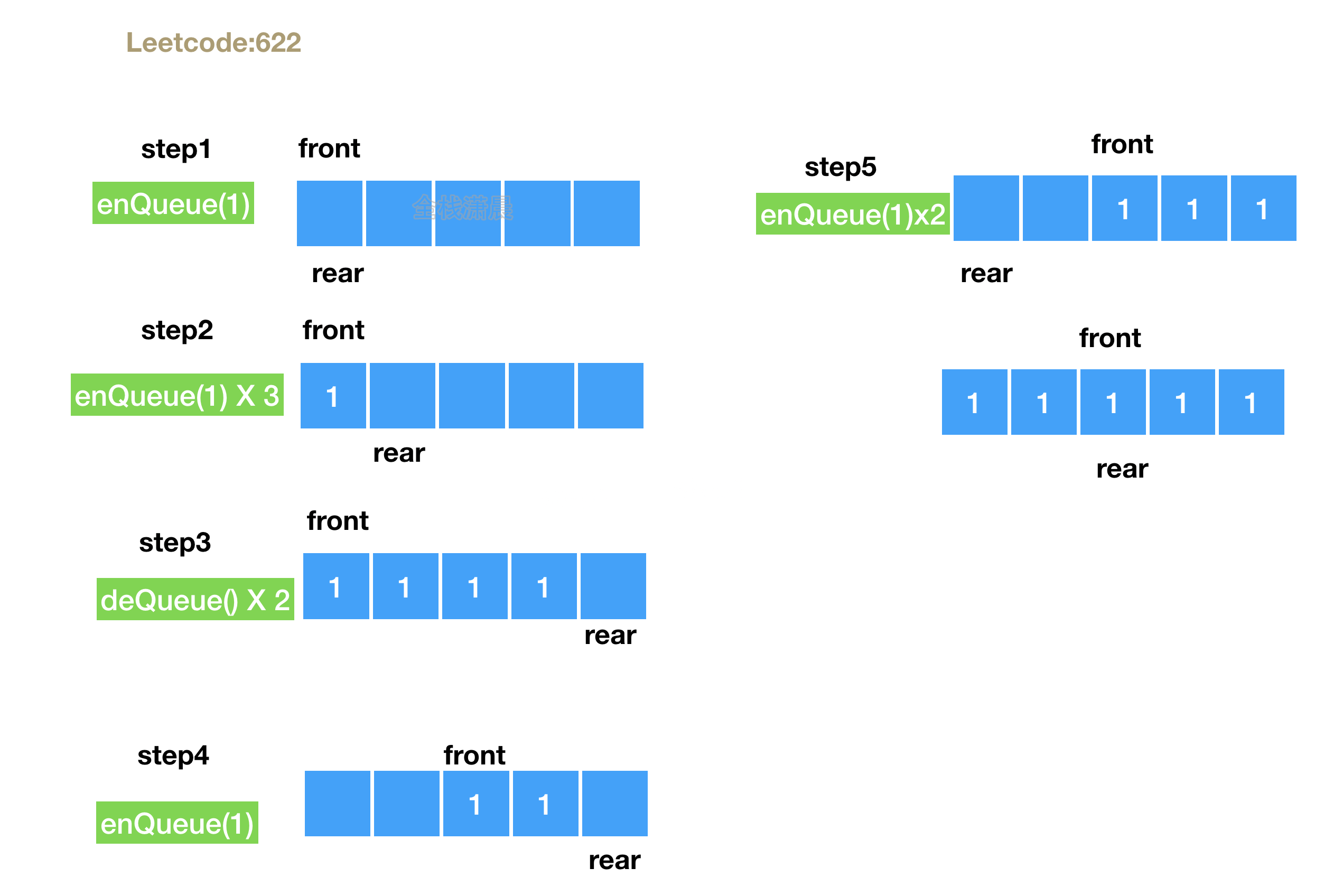
js:
var MyCircularQueue = function(k) {
this.front = 0
this.rear = 0
this.max = k
this.list = Array(k)
};
MyCircularQueue.prototype.enQueue = function(value) {
if(this.isFull()) {
return false
} else {
this.list[this.rear] = value
this.rear = (this.rear + 1) % this.max
return true
}
};
MyCircularQueue.prototype.deQueue = function() {
let v = this.list[this.front]
this.list[this.front] = undefined
if(v !== undefined ) {
this.front = (this.front + 1) % this.max
return true
} else {
return false
}
};
MyCircularQueue.prototype.Front = function() {
if(this.list[this.front] === undefined) {
return -1
} else {
return this.list[this.front]
}
};
MyCircularQueue.prototype.Rear = function() {
let rear = this.rear - 1
if(this.list[rear < 0 ? this.max - 1 : rear] === undefined) {
return -1
} else {
return this.list[rear < 0 ? this.max - 1 : rear]
}
};
MyCircularQueue.prototype.isEmpty = function() {
return this.front === this.rear && !this.list[this.front]
};
MyCircularQueue.prototype.isFull = function() {
return (this.front === this.rear) && !!this.list[this.front]
};